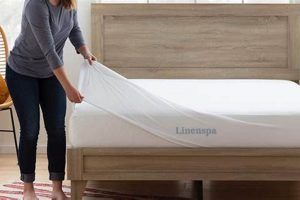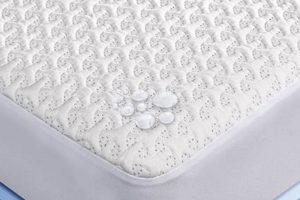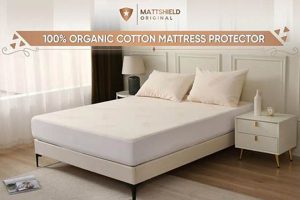A specialized bedding item designed to shield a mattress from moisture and stains resulting from nocturnal enuresis. These items create a barrier, preventing liquids from penetrating the mattress core and potentially causing damage or fostering bacteria growth. For instance, a parent might use this on a child’s bed to maintain hygiene and extend the life of the mattress.
The use of such protectors is crucial for maintaining a clean and hygienic sleep environment. They offer significant benefits including preventing unpleasant odors, inhibiting mold and mildew growth, and simplifying cleanup after accidents. Historically, simpler methods were employed, but modern versions utilize advanced materials offering superior waterproof qualities and breathability, improving comfort and protection.
The following discussion will delve into different types of protective bedding, their features, selection criteria, and best practices for care and maintenance. Understanding these aspects will allow for informed decisions when choosing appropriate bedding solutions.
Practical Guidance
Effective utilization of specialized bedding requires careful consideration of several factors to maximize its protective capabilities and longevity.
Tip 1: Prioritize Material Quality: Opt for protectors made from materials like polyurethane or thermoplastic polyurethane (TPU) that offer a waterproof yet breathable barrier. This helps prevent moisture accumulation while maintaining sleep comfort.
Tip 2: Ensure a Secure Fit: Select a protector with deep pockets and a secure encasement system, such as elastic banding or a zippered closure, to prevent shifting during sleep. A properly fitted protector will remain in place, providing consistent coverage.
Tip 3: Regularly Launder the Protector: Follow the manufacturer’s instructions for cleaning. Routine washing not only maintains hygiene but also prevents the buildup of allergens and dust mites. Frequency will depend on usage and the occurrence of accidents.
Tip 4: Consider Absorbency Features: Some protectors include an absorbent layer to quickly wick away moisture. This can be particularly beneficial for managing larger volumes of liquid. Look for materials like cotton or bamboo.
Tip 5: Evaluate Noise Levels: Older vinyl protectors can be noisy. Modern options often incorporate quieter materials. If noise is a concern, read reviews or test the protector beforehand to ensure it doesn’t disrupt sleep.
Tip 6: Invest in Multiple Protectors: Having a spare protector allows for immediate replacement during laundering. This ensures continuous protection and minimizes the risk of damage to the mattress.
Tip 7: Check for Certifications: Look for certifications like OEKO-TEX, which indicate the product has been tested for harmful substances. This is especially important for children and individuals with sensitivities.
Adhering to these recommendations contributes to a cleaner, more comfortable, and hygienic sleep environment, while simultaneously safeguarding the mattress from irreversible damage. Selecting the right product and maintaining it properly are essential for maximizing its value.
The subsequent sections will address specific product comparisons and delve into advanced material technologies used in protective bedding solutions.
1. Waterproof Material
The presence of waterproof material is a defining characteristic of a bedding item designed to protect against bed wetting. The effectiveness of a such item is directly correlated to the quality and impermeability of this waterproof layer. Without an effective waterproof barrier, liquids permeate the protector, negating its function and potentially causing damage to the mattress. This cause-and-effect relationship underscores the critical importance of this material within the overall design.
Examples of waterproof material include polyurethane films, vinyl, and specialized fabrics with waterproof coatings. Ineffective waterproof construction leads to problems such as stains, odors, and the growth of mold or mildew within the mattress. Conversely, protectors employing high-quality waterproof material offer protection against these outcomes and ease of cleaning. Failure to incorporate superior waterproof material in manufacturing renders the protector ineffective and unable to serve its intended purpose.
The utilization of waterproof material is central to preventing mattress damage from nocturnal enuresis. The protector’s capacity to function as a barrier against liquids entering the mattress substantially increases its value as a defense against hygiene issues. The appropriate choice of materials substantially minimizes the risk of moisture-related damage, affirming that proper application of waterproof materials in protector construction is a crucial performance criteria.
2. Breathability
Breathability is a critical attribute of any effective barrier, particularly one used for managing nocturnal enuresis. It represents the ability of the material to permit the passage of air and moisture vapor, preventing the accumulation of heat and humidity between the protector and the sleeper.
- Regulation of Body Temperature
Impermeable materials can trap body heat, leading to discomfort and disrupted sleep. Breathable protectors allow for the dissipation of heat, contributing to a more consistent and comfortable sleep temperature. This feature is especially important for children and individuals prone to overheating.
- Moisture Management
Breathable materials facilitate the evaporation of perspiration, preventing the buildup of moisture on the sleep surface. The consequence of restricted breathability is a damp environment that can promote the growth of bacteria and allergens, thereby compromising hygiene.
- Material Selection
The breathability of a mattress protector depends significantly on the material used. Polyurethane laminates, for example, are often used as a waterproof barrier, but the density and pore size of the laminate determine its breathability. Woven fabrics with a waterproof membrane, like some types of polyester, can offer a better balance between water resistance and air permeability.
- Impact on Sleep Quality
Discomfort due to excessive heat or humidity can lead to frequent awakenings and a decrease in the overall quality of sleep. By promoting a more comfortable sleep environment, breathable mattress protectors contribute to improved sleep patterns. The choice of a breathable option becomes particularly significant for those with sensitive skin or pre-existing respiratory conditions.
The breathability of a protector, therefore, is not merely a matter of comfort but also contributes to maintaining hygiene and promoting optimal sleep. Its importance is heightened when considering the potential consequences of trapped moisture and elevated temperatures in the context of bed wetting. Selecting a protector that balances waterproof capabilities with breathability is essential for effective management.
3. Absorbency Level
The absorbency level is a critical factor in determining the effectiveness of a specialized bedding item designed to safeguard mattresses from bed wetting incidents. It quantifies the volume of liquid that the protector can contain without seepage, thereby influencing the degree of protection offered and the frequency of required laundering.
- Material Composition and Absorbency
The materials used in construction significantly impact a protector’s ability to absorb liquids. Protectors with layers of cotton, bamboo, or microfiber tend to have higher absorbency compared to those with only a thin waterproof membrane. For example, a protector with multiple layers of cotton fleece will generally retain more liquid than one with a simple polyurethane coating, thus minimizing the risk of moisture reaching the mattress.
- Impact on Sleep Hygiene
Higher absorbency reduces the likelihood of liquid pooling on the surface, which can contribute to skin irritation and discomfort. Furthermore, by containing the liquid, it minimizes the potential for odor and bacterial growth. In practice, this means that a highly absorbent protector creates a drier and more hygienic sleep environment, which is particularly important for individuals prone to nocturnal enuresis.
- Frequency of Laundering
The absorbency level directly affects how often the protector needs to be washed. Protectors with low absorbency may require more frequent laundering, especially in cases of larger accidents. This can lead to increased wear and tear and higher maintenance costs. Conversely, a high-absorbency protector can often manage multiple smaller incidents before requiring washing, extending its lifespan and reducing the laundry burden.
- Considerations for Different Needs
The optimal absorbency level depends on individual needs and the severity of the bed wetting. Children or adults who experience frequent or heavy incidents may benefit from protectors with very high absorbency capabilities. Conversely, those with occasional or light occurrences may find that a moderately absorbent protector is sufficient. Matching the absorbency level to the specific need is crucial for effective mattress protection and cost management.
In summary, the absorbency level is a key performance indicator of a bedding item designed for bed wetting, influencing its effectiveness in containing liquids, maintaining hygiene, and minimizing maintenance. Selecting a protector with an appropriate absorbency level is essential for achieving optimal protection and ensuring a comfortable sleep environment.
4. Secure Encasement
Secure encasement, in the context of bedding designed for nocturnal enuresis, refers to a design that fully surrounds the mattress, providing protection on all six sides. This feature is critical for preventing liquids from reaching the mattress, thereby avoiding stains, odors, and the growth of mold or mildew. Without a secure encasement, even a waterproof top layer can be compromised by liquids seeping in from the sides or underneath. The absence of complete coverage can lead to unsanitary conditions and premature mattress degradation. For example, a protector that only covers the top surface, leaving the sides exposed, offers inadequate defense against spills or accidents that may occur during sleep. The consequence of inadequate encasement is often the need for mattress replacement, incurring additional expense and inconvenience.
The practical significance of secure encasement extends beyond merely preventing surface stains. It contributes to maintaining a hygienic sleep environment by creating a barrier against dust mites and allergens. A fully encased protector with a zipper closure, for instance, effectively seals off the mattress, preventing these irritants from colonizing within the mattress fibers. This is particularly beneficial for individuals with allergies or asthma. Furthermore, secure encasement enhances the lifespan of the mattress by safeguarding it from wear and tear. The design prevents the mattress from shifting or sagging, thereby preserving its structural integrity. Regular use of a fully encased protector can significantly extend the useful life of a mattress, representing a cost-effective approach to maintaining a comfortable and sanitary sleep surface.
In summary, secure encasement is not merely a feature of a protective bedding item; it is a fundamental requirement for effective defense against the effects of nocturnal enuresis. This design element safeguards the mattress from liquid damage, maintains a hygienic sleep environment, and extends the mattress lifespan. Understanding its importance enables informed purchasing decisions, ensuring that the chosen protective solution offers comprehensive protection and long-term value.
5. Ease of Cleaning
The characteristic of effortless maintenance is fundamentally linked to the utility of protective bedding designed for managing nocturnal enuresis. Protectors that simplify the cleaning process offer practical benefits, reducing the burden of hygiene management and promoting longevity.
- Washability
The ability to launder a protector in a standard washing machine is crucial. Protectors that require specialized cleaning methods, such as dry cleaning or hand washing, are less convenient and may be less likely to be cleaned regularly. Machine washability ensures that the protector can be easily sanitized, removing urine, sweat, and other contaminants. For instance, a protector that can be washed and dried using conventional appliances streamlines the cleaning process, promoting hygiene and convenience.
- Quick Drying Time
A short drying time is essential for prompt reuse. Protectors that take extended periods to dry can create logistical challenges, particularly in situations where frequent changes are necessary. Materials that facilitate rapid drying, such as lightweight polyester or microfiber, minimize the downtime of the protector and ensure that a clean replacement is readily available. Reduced drying time translates to greater efficiency in maintaining a sanitary sleep environment.
- Stain Resistance
Protectors with stain-resistant properties simplify the removal of stains from urine and other bodily fluids. Materials treated with stain-repellent finishes prevent stains from setting, making them easier to clean during laundering. This not only improves the aesthetic appearance of the protector but also contributes to its longevity, as repeated aggressive cleaning can degrade the material over time. A stain-resistant surface ensures that the protector remains sanitary and visually appealing despite repeated use.
- Durability of Waterproof Layer
The waterproof layer’s ability to withstand repeated washing is paramount. Inexpensive protectors may lose their waterproof properties after only a few washes, rendering them ineffective. High-quality protectors maintain their waterproof integrity even after numerous laundering cycles, providing consistent protection over time. The durability of the waterproof layer is a key indicator of the protector’s overall quality and value, ensuring that it continues to perform its intended function throughout its lifespan.
These attributes collectively underscore the importance of effortless maintenance in bedding designed for nocturnal enuresis. The ease with which a protector can be cleaned directly impacts its practicality, hygiene, and longevity, making it a crucial factor in the selection process. Protectors that prioritize ease of cleaning offer a more convenient and effective solution for managing the challenges associated with bed wetting.
6. Allergen Barrier
The presence of an effective allergen barrier is an important consideration when selecting bedding protection. This feature contributes to a healthier sleep environment, particularly for individuals susceptible to allergies or asthma, and enhances the overall value of the protective bedding.
- Prevention of Allergen Accumulation
The primary role of an allergen barrier is to prevent dust mites, pet dander, mold spores, and other common allergens from penetrating the mattress. Mattresses can accumulate substantial quantities of these allergens over time, exacerbating allergic reactions and respiratory issues. A tightly woven fabric or a specialized membrane within the protector creates a physical barrier that inhibits allergen penetration. For example, a densely woven microfiber protector prevents dust mites from entering the mattress core, reducing exposure to these common triggers.
- Reduction of Allergic Symptoms
By minimizing allergen exposure, an effective barrier can reduce the frequency and severity of allergic symptoms such as sneezing, coughing, itchy eyes, and skin irritation. This is particularly important for individuals who spend a significant portion of their time in bed. For instance, a child with asthma may experience fewer nighttime asthma attacks when sleeping on a mattress protected by an allergen barrier, leading to improved sleep quality and overall well-being.
- Material Selection and Construction
The effectiveness of an allergen barrier depends on the material and construction of the protective bedding. Tightly woven fabrics, such as microfiber with a pore size smaller than the average dust mite, are highly effective. Additionally, protectors with zippered encasements provide comprehensive coverage, sealing off the entire mattress from allergen intrusion. In contrast, protectors with loose weaves or incomplete coverage may offer limited allergen protection.
- Long-Term Mattress Hygiene
An allergen barrier contributes to long-term mattress hygiene by preventing the buildup of allergens within the mattress fibers. This reduces the need for aggressive cleaning methods that can damage the mattress. By maintaining a cleaner and more hygienic sleep surface, the protector extends the lifespan of the mattress and contributes to a healthier indoor environment. The long-term benefits of allergen protection make it a worthwhile investment for individuals concerned about indoor air quality and allergy management.
These aspects highlight the significance of an allergen barrier within the context of protective bedding. By preventing allergen accumulation, reducing allergic symptoms, and promoting long-term mattress hygiene, an effective allergen barrier enhances the functionality and value of specialized bedding items, creating a cleaner and more comfortable sleep environment for all users.
Frequently Asked Questions
This section addresses common inquiries regarding protective bedding designed for nocturnal enuresis, providing clarity on pertinent aspects of selection, utilization, and maintenance.
Question 1: How frequently should mattress protectors be laundered?
Laundering frequency depends on usage and incident occurrence. Routine washing, approximately every 1-2 weeks, is advisable to maintain hygiene. Following accidents, immediate laundering is necessary to prevent stains and odor.
Question 2: What materials offer the most effective waterproof protection?
Polyurethane laminate (PUL) and thermoplastic polyurethane (TPU) are widely recognized for their waterproof characteristics while maintaining breathability. Vinyl provides a waterproof barrier but typically lacks breathability.
Question 3: Do mattress protectors alter the comfort of the mattress?
Protectors with breathable materials and a smooth surface typically have minimal impact on mattress comfort. Bulky or non-breathable protectors may alter the feel of the mattress.
Question 4: Can mattress protectors eliminate odors caused by bed wetting?
Protectors prevent urine from penetrating the mattress, thereby preventing odor buildup within the mattress core. Existing odors within the mattress itself may require separate treatment.
Question 5: Are all mattress protectors suitable for individuals with allergies?
Protectors with a tightly woven fabric or a dedicated allergen barrier can reduce dust mite and allergen exposure. Certifications such as OEKO-TEX indicate testing for harmful substances, benefiting sensitive individuals.
Question 6: How does one ensure the protector fits the mattress properly?
Measure the mattress depth and select a protector with appropriately sized deep pockets. Elastic banding or zippered encasements further enhance secure fit and prevent slippage.
In summary, proper selection and maintenance are essential for maximizing the effectiveness of protection. Choosing protectors with suitable waterproof materials, breathable construction, and a secure fit ensures both hygiene and comfort.
The subsequent section will discuss advanced technologies and emerging trends in protective bedding for managing nocturnal enuresis.
Conclusion
The investigation into mattress protector for bed wetting reveals a multifaceted solution for a common issue. Key attributeswaterproof materials, breathability, absorbency levels, secure encasement, ease of cleaning, and allergen barriersdefine the efficacy and usability of these products. Selecting the appropriate bedding requires careful consideration of these elements to ensure optimal protection and hygiene.
The continued innovation in material science and design promises further advancements in protective bedding. A commitment to informed purchasing, coupled with diligent maintenance, remains essential for safeguarding mattresses and fostering a healthier sleep environment. The impact of thoughtfully chosen and well-maintained bedding extends beyond mere protection, contributing to improved comfort and well-being.







![Shop Best Tencel Mattress Protector [Eco-Friendly] Organic & Natural Mattress Buyer’s Guide: Non-Toxic Sleep Solutions Shop Best Tencel Mattress Protector [Eco-Friendly] | Organic & Natural Mattress Buyer’s Guide: Non-Toxic Sleep Solutions](https://mattressworldpa.com/wp-content/uploads/2025/07/th-2502-300x200.jpg)